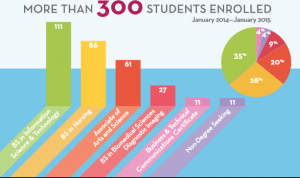Key takeaways
- The UW Flexible Option business plan includes leadership, educational support, and operations centralized for efficiency for this multi-institutional collaboration.
Read more...
University of Wisconsin-Extension senior management provides overall leadership for UW Flex, and UW-Extension houses centralized functions, including: academic and student support, such as the function of Academic Success Coaches; marketing and recruitment support (staff and media buys); operational support (such as for admissions and financial aid initially and later including registrar and bursar functions); and technology.

Student support is centralized. This centralized structure is designed to allow an economy of scale essential for financial viability and to produce consistency and seamlessness in the student experience.
- UW Flexible Option funding comes from multiple sources.
Read more...
The UW Flexible Option’s start-up funding included one-time resources from the University of Wisconsin System, reallocated funds from UW-Extension, and foundation support. Ongoing, UW Flex operates as a program revenue model designed to recover direct costs (marketing, recruitment, faculty, instructional design, student services, and academic program management) through tuition. Tuition options include $900 for a single competency subscription and $2,250 for an all-you-can-learn subscription. Subscriptions are for three-month periods. One exception is the Substance Use Disorders Counselor certificate, for which the subscription period is extended to six months.
- The UW Flexible Option program revenue cost-recovery model includes revenue sharing between UW-Extension and UW partners.
Read more...
Each academic program is intended to be self-sustaining within three to five years of initial student enrollment. When enrollments generate revenue exceeding the program’s break-even amount, revenue is shared among partner institutions for that program. These business practices are consistent with other online programs already offered collaboratively by the University of Wisconsin-Extension and partner UW institutions.
During the fiscal year ending June 30, 2017, the UW-Madison Professional Certificate in Substance Use Disorders became the first UW Flex program to produce net revenues.
If enrollment patterns continue, senior leaders expect that the next two UW Flex programs to generate net revenues will be Information Science and Technology and Nursing (RN to BSN). Both degree programs are offered through UW-Milwaukee.
Program revenue retained by UW-Extension is reinvested into UW Flex for curriculum revision; development of additional academic programs, which each cost approximately $1 million in start-up funding; and UW-Extension’s other strategic initiatives.
- A vetted, strategic, well-developed business plan serves as a roadmap for the UW Flexible Option.
Read more...

Budget planners routinely review projected expenses and revenues. UW Flex was developed in collaboration with the University of Wisconsin System president, chancellors, and governance groups and was guided by three ad hoc advisory groups. UW Flex was created with the intent to expand access to high-quality UW degrees and programs, empowering nontraditional students in Wisconsin and beyond to achieve their educational and career goals through a flexible, personalized, convenient CBE program. UW Flex was designed to focus on degrees in the greatest demand in health care, technology, and business. UW Flex leaders’ intent remains to offer an additional path for students to pursue those careers, rather than to duplicate or compete with existing programs at UW institutions.
The UW Flex business plan contains the following sections:
- The program purpose or mission statement describing, in broad terms, students targeted and the program, such as: “The University of Wisconsin will provide nontraditional students with high-quality, competency-based, personalized learning opportunities, along with the academic and student services needed to help students succeed.”
- The academic programs, which for UW Flex, included the first cohort of programs planned and a brief description of the number and kinds of other programs that could follow.
- Critical success factors, which for UW Flex, included several detailed in the takeaway below, such as: “Having the right information technology infrastructure and systems in place to support adult student learning, the innovation of the UW Flexible Option model, and sound business practices for the UW System.”
- The operational plan, which organized UW Flex business and financial assumptions around six topics: pricing options, enrollment projections, the academic process, the student success process, program management, and marketing and recruitment.
- The financial plan, for which the student life cycle and tuition subscription period projections were critical to UW Flex leaders’ estimates of expenses and revenues. They continue to routinely review those projections and remain conservative until data is available to support more aggressive growth projections.
- The marketing strategy, which the UW Flex marketing team developed as a largely online marketing strategy including some common messages regarding quality, benefits, affordability and flexibility, and other specific messages tailored to audience segments.
- Challenges, which for UW Flex included significant investments required, institutional cultures in a decentralized institution, lack of a common student records system, and accreditation, financial aid, and other regional and federal regulatory issues.
The UW Flexible Option business plan outline and template provided in the “More detail” section below also include an executive summary and overview.
Also provided in “More detail” below is a financial report template that allows users to create a simple overview showing projected and actual revenues and and expenditures by fiscal year and by month. Others may prefer working through the detailed online model developed by the National Center for Higher Education Management Systems (NCHEMS), which developed a CBE Cost Model sample and blank worksheet for estimating expenses and revenue.
- Measurement of progress and transparent, regular communication of that progress allow timely, data-informed decisions that are consistent with the business plan.
Read more...

While year-end reporting is important, monthly monitoring allows timely adjustments for the UW Flexible Option. The financial success of UW Flex depends on metrics that track student participation and the demand on resources. Transparent communication means program designs, budgets, progress, enrollments, and expenses are presented to senior management in straightforward formats in a timely manner.
Programs with monthly enrollment, such as UW Flex, require monthly monitoring. This allows program leaders to change direction as needed, rather than waiting for fiscal year-end reports.
- The UW Flexible Option business plan identifies five factors critical to the success of this model.
Read more...

UW Flex success depends on delivering programs in high job-growth areas. - Offering programs that address strong employment needs and public interest, high job-growth areas, and student demand (health care, technology, and business).
- Establishing a clearly defined organizational structure with a complementary set of business processes to support institutional effectiveness and innovative teaching and learning in the advancement of higher education.
- Providing a learning environment that is responsive to the needs of nontraditional students, including maximum flexibility and frequent and proactive interactions to ensure student progress and success.
- Putting the right information technology infrastructure and systems in place to support nontraditional student learning, the innovation of the UW Flexible Option model, and sound business practices for the UW System.
- Building economies of scale through effective delivery of what nontraditional students want and need, and efficient use of necessary resources.
Challenges
- Enrollment models did not exist because direct assessment competency-based education was too new.
Read more...

Resource estimates follow the student life cycle from
recruitment to graduation.
UW Flex early response: These models would have helped in projections. Instead UW Flex budget planners based projections on comparable programs delivered face-to-face and online, such as those pathways to a Bachelor of Science in Nursing degree through UW-Milwaukee. To estimate resources needed to serve projected enrollments, they analyzed a projected UW Flex student life cycle. That analysis yielded UW Flex-specific needs for human resources, capital, and facilities. To determine the costs of those resources, they adapted estimates from other online and collaborative programs managed by UW-Extension.
Looking forward from 2017: Budget models will improve as student data becomes more plentiful.
- Decentralized financial and human resources, as well as institutional cultures, created barriers to development of this collaboration.
Read more...
UW Flex early response: Creating a new program—especially one for which no model existed— required new and significant resources, including a one-time investment by the University of Wisconsin System and substantial reallocation of human resources supported within UW-Extension for the start-up phase. Barriers included the hiring timeline through existing human resources processes, the need to cover existing initiatives during the reallocation stage, and the need to work out financial arrangements across UW institutions with different budget systems and different institutional cultures.
Looking forward from 2017: UW Flex leaders expect that institutional partners offering academic programs will support a unified set of business processes and procedures, understand (via data from existing programs) that UW Flex complements rather than competes with their more traditional program offerings, and recognize the potential for cost recovery and revenue sharing (based on existing programs’ success). UW Flex academic programs are expected to reach the break-even point within three to five years after enrolling students, with subsequent program revenues supporting the revision of existing programs and the development and launch of additional academic programs.
- Lack of a common student information system impacted the ability to make data-driven budget decisions.
Read more...
UW Flex early response: When UW Flex launched in 2013-14, no off-the-shelf student records systems met program needs for systems that were highly student-centric, integrated across campus student systems, and not built for academic terms, credits, or seat time. UW Flex staff were forced to spend time and money on a solution that applied uniquely to UW Flex instead of allocating those resources for data analysis. They used the Salesforce customer relations management (CRM) tool for recruitment and admissions and the cloud-based Regent 8 software for financial aid, and then invested resources to modify both to work with campus-based instances of Oracle (PeopleSoft) student records databases.
Looking forward from 2017: A Student Engagement System will enable efficient and scalable multi-institutional program delivery. The Student Engagement System uses a standardized student records database that will allow modules (such as for recruitment, enrollment, financial aid, and transcription) to easily “plug in” and “plug out.”
- Accreditation, financial aid, and other regional and federal regulatory policies were not yet adapted for direct-assessment CBE.
Read more...
UW Flex early response: Federal regulatory and regional accrediting bodies struggled with CBE approaches to higher education, leading to the need to create new policies and practices that did not revolve around credits and seat time. UW Flexible Option senior leaders participated in iterative processes with the U.S. Department of Education and accreditors about policies and practices essential for the delivery of high-quality CBE and the allocation of Title IV federal financial aid. UW Flex leaders helped advance the national discussion about CBE, including through the Competency-Based Education Network (C-BEN).
While financial aid policies were being approved, UW-Extension offset the cost of tuition through a self-funded, internal, tuition credit program. This ensured that eligible students could receive tuition relief before UW Colleges received approval to award Title IV financial aid in 2014 and UW-Milwaukee approval followed in 2015.
Looking forward from 2017: UW Flex leaders welcome continued opportunities to provide input to governing agencies and accreditors as they establish regulations, policies, and processes related to CBE.



